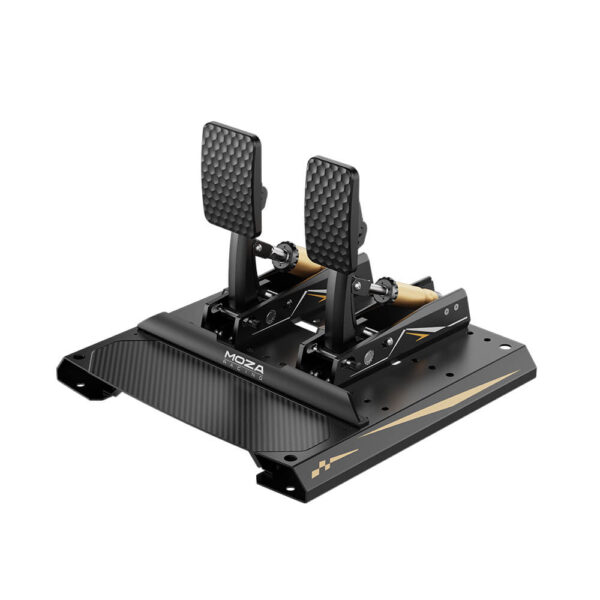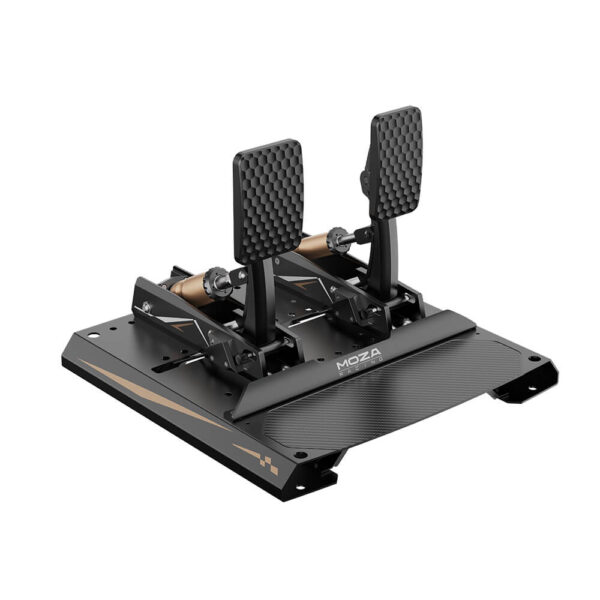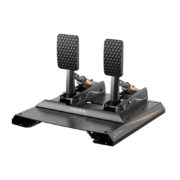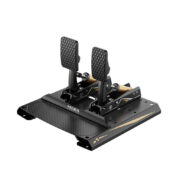Mô tả
MOZA Racing has become pretty much part of the furniture in the sim racing market over the past year or two. Their strategy: start at a budget, hyper-accessible price point, grow to a dominant position in market, and then use revenue investment to develop into a more complete range of mid to high-end gear. Seems to be working so far.

While Moza has been making announcements at pace, both in sim racing and flight sim, today, I have the CRP2 pedals fitted to my brand new Sim-Lab P1-X
As an evolution of their previous CRP model, the new versions have generated a pretty decent buzz, with most users reporting a substantial improvement over the CRP1 model, addressing shortcomings and making key improvements throughout.
Let me take you through my experience with them, from unboxing to long-term use.
First Impressions and Design
CRP2 stand out with a matt-finished, modern aesthetic. Each pedal is in a protective bag, with the box featuring all required fittings and base plate.
The CRP2’s features a minimalist design and a complimentary black and gold colour scheme. The hexagonal design elements on the pedal face add a nice premium feel to the design.

Wiring is neat and tidy out of each individual pedal body, with the ultimate location for all of them to terminate in the pedal control box, located on the pedal base.

As with several Moza items I’ve looked at recently, there are always improvements in the design and manufacturing to appreciate.
The pedal faces are crafted from CNC-machined, aerospace-grade aluminium alloy. You can feel the matte, anodised finish. The base, made from high-strength steel, felt reassuringly solid (it’s quite heavy which I think is a good thing) – it’s designed to withstand the intense forces we apply during racing, and I’d guess that it wouldn’t be impossible to run it on the office floor with the right feet. It’s certainly so much heavier than the cheaper SRP pedal set.

On the pedal base, there’s a nice carbon fibre heel plate. It’s a small, but sporty touch and provides a little friction for consistent heel positioning. As with many consumable items, like heel plates, expect them to wear with use.
Build Quality and Materials
Mounting the pedals to my rig, the build quality posed no installation issues. All holes aligned neatly with my 8020 pedal profile (I mounted them directly on profile, and used the controller box placed under the rig pedal plate).

The weight of each pedal feels right, and key components are constructed well. All items move smoothly and noiselessly.
The good news about this pedal set is that it’s load cell-based. The load cell in the brake pedal is rated at 200kg. As I often mention, 200kg load sessions per lap, they’ll be at least 20 – for me that’s way too much. You can calibrate a maximum force that works better for you in Moza Pit House. All very easy and no trouble at all.

I found I preferred to push at my usual 120-130kg which gets the cell nowhere near its maximum limit.
Installation and Adjustability
Setting up the CRP2 pedals on the P1-X was completely straightforward. The pedals (intended to mount on the provided mounting plate) come with all necessary mounting fixtures. Me being me, I prefer not to use the manufacturer supplied plates (sorry) and mount directly to 8020 (much like I did with the Conspit pedals).

I had mine installed and ready to go in about 15 minutes, feeding the cables to the controller box located on the underside of the pedal tray.
Where these pedals shine is in their adjustability. For the money, you get:
1. Vertical placement of pedal plates
2. Adjustable angle of the pedal arm
3. Preload adjust on the springs
4. Total pedal travel distance is adjustable
The brake pedal offers 125 different feel combinations (if you were to combine very possible variation of elastomer and spring…). I found myself stiffening the default brake setting, and I left the throttle alone.
One tiny gripe: changing the brake elastomers can be fiddly. The manual actually suggests using foot pressure to disassemble the brake, which I found a bit awkward. It’s not a change you make often but clearly this is part of the product that will most likely be developed for next time.
Software and Calibration
MOZA’s Pit House software is the go to interface for pedal calibration. We’re very familiar with Pit House by now, so going through the calibration, pressure curver and adjustment processes was extremely simple.

Pedal Feel and Performance
The brake pedal, with the 200kg load cell and a 15-bit angle sensor, gives a feeling of good precision. After some initial adjustments, I found I could consistently hit my brake points and modulate pressure through corners with ease. Easy to drive with under trail braking and a smooth compression/release making driving the car smoothly very easy.
The throttle pedal uses a spring-enclosed design with a smooth guide rod. In practice, this translates to a silky pedal feel that allows for precise control, which we know is important when managing traction out of corners.
I opted for the three-pedal set, and the clutch impressed me with its realistic engagement point. It took some getting used to, but it added an extra layer of immersion to my historic racing sims.
What really stood out to me over heavy sessions of use was the consistency. Lap after lap, the pedals delivered the same feel, allowing me to build that all-important muscle memory. For the money, this is a particularly good pedal set.

Comparison to Competitors
Ultimately, it’s about money. The CRP2 pedals hold their own in the mid (HE Sprints) to higher-end market. They wipe the floor with Fanatec’s current line up (sorry) They offer a level of adjustability and precision that’s comparable to more expensive options. Combined with the Vision GS wheel and an R9 and you’ve got yourself a professional-grade cockpit for less than $1000
The improvements over the original CRP1 pedals are just, significant. The overall feel, adjustability, and build quality have all seen noticeable upgrades.
MOZA claims each pedal has undergoes one million press cycles during testing. While I haven’t quite reached that number (yet!), I’ve been impressed by their durability so far. The use of high-quality materials, brass bushings and Teflon components in moving parts, probably bodes well for long-term reliability.
Conclusion
If you’re considering a Moza setup the CRP2 pedals are a simple, easy choice. There’s a USB adapter contained in the pedal adapter box too; so these pedals would complement a Fanatec DD setup or Logitech too. Moza has found a sweet spot between performance, adjustability, and build quality that should satisfy a wide range of sim racing enthusiasts. Judging from their progress (the Vision GS, the refined CRP2 pedals), Moza are clearly committed to bringing a bit of much needed competition to the market.

Technical Specifications
To provide a more complete picture of the MOZA CRP2 pedals, here are some key technical details:
Dimensions and Weight:
– Throttle: 145 x 300 x 200mm (W x D x H), Weight: 1.36kg
– Brake: 145 x 300 x 200mm (W x D x H), Weight: 1.85kg
– Clutch (optional): 145 x 300 x 200mm (W x D x H), Weight: 1.45kg
– Control Box: 130 x 80 x 26mm (W x D x H), Weight: 0.16kg
Components:
– Pedal Body Material: Aerospace-grade aluminum alloy
– Heel Plate Material: 3K twill carbon fibre
– Base Material: High-strength steel
– Load Cell Sensor Range: 0–200kg
– Angle Sensor Resolution: 15-bit (32768 PPR)
Adjustability Range:
– Brake Travel Adjustment: 15–20°
– Throttle Travel Adjustment: 15–23°
– Clutch Travel Adjustment: 15–25°
– Pedal Angle Adjustment: 0–15°
– Pedal Face Height Adjustment: Up to 30mm
– Footrest Adjustment: Up to 30mm
Connectivity:
– Interface: USB 2.0
– Cable Length: 2m
– Connector Type: RJ12 for individual pedal connections to control box
Compatibility:
The CRP2 pedals are designed to work seamlessly with most major sim racing platforms and games. They’re compatible with PC out of the box, and can be used with Xbox consoles when paired with a MOZA Racing wheel base and Xbox-compatible wheel rim. For PlayStation compatibility, an additional DriveHub adapter is required.
The pedals use standard USB HID protocols, ensuring broad compatibility across various sim racing software. However, for optimal performance, it’s recommended to use MOZA’s Pit House software for fine-tuning and creating custom profiles.
These technical specifications underscore the CRP2 pedals’ high-end construction and extensive adjustability. The use of precision sensors and quality materials contributes to their performance and durability, while the standardized connectivity ensures they can be integrated into a wide range of sim racing setups.











